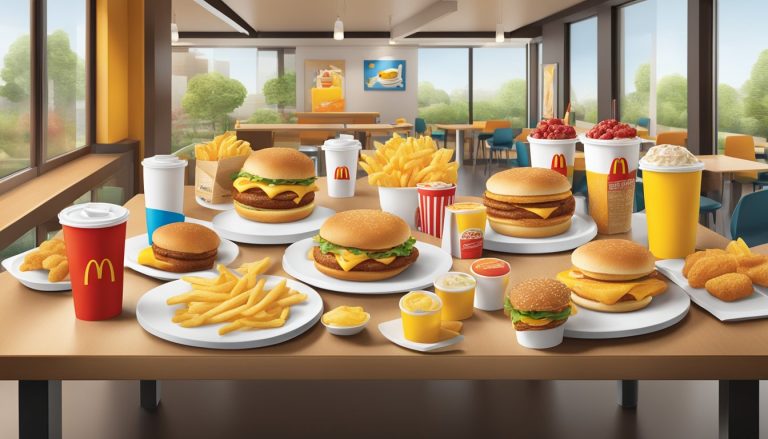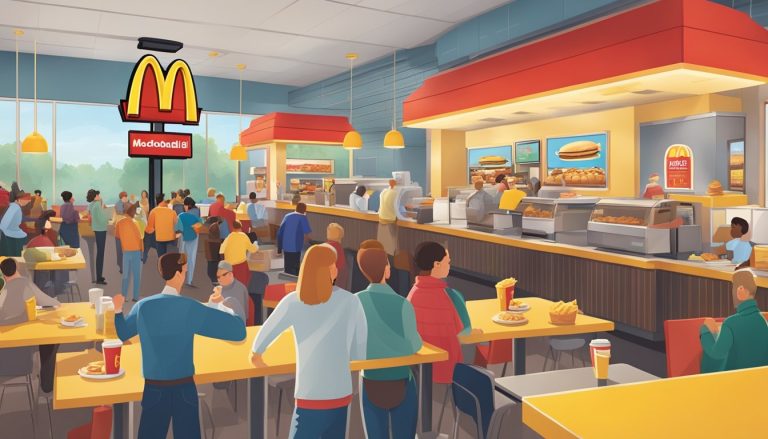McDonald’s breakfast has been a beloved staple for many fast food enthusiasts since its introduction in the 1970s. The menu offers a variety of morning favorites, from Egg McMuffins to hotcakes, satisfying cravings across the globe. McDonald’s typically serves breakfast from 5 am until 10:30 or 11 am, depending on the location.
In 2015, McDonald’s made a significant change by introducing all-day breakfast in response to customer demand. This move allowed patrons to enjoy breakfast items beyond the traditional morning hours, catering to those who craved breakfast foods later in the day. The concept of “breakfast all day” became popular among customers who missed the usual breakfast cutoff time.
However, in 2020, McDonald’s made the decision to scale back its all-day breakfast offerings. While some locations may still offer select breakfast items throughout the day, the full breakfast menu is generally no longer available after the morning hours at most McDonald’s restaurants. This change was implemented to streamline kitchen operations and improve service efficiency.
History of McDonald’s Breakfast
McDonald’s journey into breakfast revolutionized fast food. The introduction and expansion of their morning menu transformed how millions start their day.
The Origin of the Egg McMuffin
In 1971, McDonald’s franchise owner Herb Peterson created the Egg McMuffin in Santa Barbara, California. Peterson aimed to replicate eggs Benedict in a handheld format. He used a round egg, Canadian bacon, and cheese on a toasted English muffin.
The Egg McMuffin quickly gained popularity. McDonald’s added it to their national menu in 1975. This marked the company’s first foray into breakfast offerings.
Expansion of the Breakfast Menu
Following the success of the Egg McMuffin, McDonald’s expanded its breakfast options. In 1977, they introduced a full breakfast menu nationwide. New items included hotcakes, sausage, and hash browns.
The breakfast menu continued to evolve over the years. McDonald’s added options like the Sausage McMuffin, Bacon Egg and Cheese Biscuit, and McGriddles. These additions catered to diverse taste preferences and regional markets.
By the early 2000s, breakfast accounted for about 15% of McDonald’s sales. The morning menu became a significant revenue driver for the company.
The Demand for Breakfast Options
Consumer preferences for breakfast have evolved significantly, with more people seeking flexible meal options throughout the day. This shift has prompted fast food chains to adapt their menus and serving times.
Market Trends in Morning Meals
Breakfast has become an increasingly important meal for many consumers. Time constraints and changing work schedules have led to a rise in on-the-go breakfast options.
A survey by Instantly, Inc. found that 72% of consumers believe fast-food chains should offer breakfast all day. This indicates a strong demand for morning-style meals beyond traditional hours.
The popularity of breakfast items has also contributed to the globalization of breakfast culture. Foods like McMuffins and hash browns have gained widespread appeal across different markets.
Competitors’ Influence
McDonald’s introduction of all-day breakfast in 2015 was a response to growing customer demand and competitive pressures. This move forced many rivals to reevaluate their own breakfast strategies.
Dunkin’ and Starbucks have expanded their breakfast menus and serving hours to compete. These chains have introduced new items and improved existing offerings to attract morning customers.
The breakfast segment has become a key battleground for fast-food chains. Companies are investing in menu innovation and marketing to capture a larger share of the breakfast market.
All-Day Breakfast Implementation
McDonald’s decision to offer breakfast items throughout the day marked a significant shift in their operations. This change expanded menu options and aimed to boost sales during traditionally slower periods.
Introduction of All-Day Breakfast Menu
McDonald’s launched its all-day breakfast menu in October 2015. The move allowed customers to purchase popular breakfast items like Egg McMuffins and hash browns at any time. Initially, the all-day menu featured a limited selection of breakfast foods.
The implementation required adjustments to kitchen equipment and procedures. Franchises had to adapt their cooking processes to accommodate both breakfast and lunch items simultaneously. This change posed challenges for some locations with limited kitchen space.
McDonald’s gradually expanded the all-day breakfast menu over time. They added more items based on customer demand and operational feasibility. The company also allowed individual franchises some flexibility in choosing which breakfast items to offer all day.
Customer Reception and Sales Impact
The introduction of all-day breakfast was met with enthusiasm from many customers. People appreciated the increased flexibility in meal choices throughout the day. This positive reception translated into a boost in sales for McDonald’s.
In the quarters following the launch, McDonald’s reported increased customer traffic and higher sales figures. The all-day breakfast menu attracted new customers and encouraged existing ones to visit more frequently. Some locations saw a significant uptick in breakfast item sales during lunch and dinner hours.
However, the impact varied across different franchises. Some reported operational challenges and increased complexity in food preparation. The all-day breakfast implementation also affected the sales of traditional lunch and dinner items in some locations.
Operational Challenges of All-Day Breakfast

Serving breakfast items throughout the day presented significant operational hurdles for McDonald’s restaurants. The extended hours required major adjustments to kitchen setups and equipment usage.
Adapting Kitchen Operations to Extended Hours
McDonald’s kitchens were originally designed to transition smoothly from breakfast to lunch menus. Extending breakfast service disrupted this flow. Grills and toasters needed constant reconfiguration to handle both breakfast and regular menu items simultaneously. This slowed down food preparation and impacted overall kitchen efficiency.
Staff had to juggle cooking procedures for eggs, pancakes, and hash browns alongside burgers and fries. The complexity increased order fulfillment times. Franchisees reported difficulties maintaining quality standards across all menu items during peak hours.
Storage space became a critical issue. Keeping breakfast ingredients fresh and readily available all day required additional refrigeration units. This created cramped working conditions in many locations.
Use of Universal Holding Cabinets
Universal Holding Cabinets (UHCs) played a crucial role in facilitating all-day breakfast. These temperature-controlled units allowed staff to store both hot and cold items together. UHCs helped maintain food quality and safety standards throughout extended service hours.
Restaurants needed to invest in multiple UHCs to accommodate the expanded menu. This represented a significant capital expense for franchisees. Proper UHC management required frequent temperature checks and stock rotation.
Staff needed additional training to use UHCs effectively. Balancing inventory levels became more challenging, as breakfast item demand varied throughout the day. Some locations struggled with food waste when breakfast items didn’t sell as expected during non-traditional hours.
McDonald’s Breakfast Menu Offerings
McDonald’s breakfast menu features a mix of classic favorites and newer additions. The offerings range from hearty sandwiches to lighter options, catering to various tastes and preferences.
Classic Breakfast Items
The Egg McMuffin remains a staple of McDonald’s breakfast menu. This iconic sandwich consists of a toasted English muffin, Canadian bacon, a freshly cracked egg, and melted American cheese. Hash browns are another beloved item, offering a crispy potato side to complement any breakfast choice.
Hotcakes are a sweet option for those craving a traditional breakfast. Served with butter and syrup, they provide a comforting start to the day. For a protein-packed meal, the Sausage Burrito wraps scrambled eggs, sausage, cheese, and vegetables in a soft tortilla.
New Additions to the Breakfast Range
McDonald’s has expanded its breakfast menu to include healthier options. Fruit and maple oatmeal offers a wholesome choice, made with rolled oats and topped with fresh apple slices and cranberries. The chain has also introduced a variety of McCafé drinks, including premium roast coffee, cappuccinos, and fruit smoothies.
Breakfast sandwiches now come in more varieties. The Bacon, Egg & Cheese Biscuit adds a Southern twist to the classic McMuffin. For those seeking a larger meal, the Big Breakfast with Hotcakes combines scrambled eggs, sausage, hash browns, and hotcakes on one platter.
Nutritional Considerations for Breakfast

Breakfast choices impact daily energy levels and long-term health. The nutritional content of morning meals deserves careful consideration, especially when opting for fast food options.
Balancing Convenience with Health
McDonald’s breakfast menu offers quick options for those on-the-go. While convenient, many items are high in calories, saturated fat, and sodium. The Egg McMuffin provides 300 calories and 17 grams of protein, making it a more balanced choice. Hash browns add 150 calories and 9 grams of fat.
For a healthier start, consider oatmeal with fruit at 310 calories. It offers fiber and essential nutrients. Alternatively, the Fruit & Maple Oatmeal provides 320 calories and 6 grams of protein.
When choosing breakfast items, look for options with lean protein, whole grains, and fruits or vegetables. These nutrients support sustained energy and better overall health. Limit items high in added sugars and processed meats to maintain a balanced diet.
Portion control is key. Selecting smaller sizes or sharing larger meals can help manage calorie intake. Pairing fast food breakfast with a piece of fruit adds valuable vitamins and fiber to the meal.
McDonald’s As a Breakfast Staple
McDonald’s transformed the fast food landscape by establishing breakfast as a core part of its menu. The company’s breakfast offerings became deeply ingrained in American culture and dining habits.
The Role of Franchises in Popularizing Breakfast
McDonald’s franchise system played a crucial role in popularizing breakfast nationwide. Local franchisees adapted breakfast menus to regional tastes, ensuring widespread appeal. In Columbus, Ohio, for example, franchises helped introduce the Egg McMuffin to Midwest diners in the 1970s.
Franchisees’ ability to quickly implement new items allowed McDonald’s to expand its breakfast menu rapidly. This expansion included options like hotcakes, sausage biscuits, and hash browns. The consistent quality across franchises built customer trust in McDonald’s breakfast offerings.
Cultural Impact of McDonald’s Breakfast
McDonald’s breakfast became a cultural phenomenon, reshaping morning routines for millions. The convenience of grabbing a quick, hot breakfast on the go aligned with the fast-paced American lifestyle.
The company’s breakfast menu influenced competitors and set industry standards. Items like the Egg McMuffin became iconic, inspiring imitations across the fast food sector. McDonald’s breakfast ads and jingles entered popular culture, further cementing its place in American society.
The concept of “breakfast all day” gained traction, with McDonald’s experimenting with extended breakfast hours. This shift reflected changing consumer preferences and blurred traditional meal time boundaries.
Future of Breakfast at McDonald’s
McDonald’s breakfast offerings are poised for significant changes in the coming years. The fast food giant is exploring new menu items and service models to meet evolving customer preferences and market trends.
Innovation in Breakfast Options
McDonald’s plans to expand its breakfast menu with healthier and more diverse options. Expect to see plant-based alternatives, grain bowls, and international-inspired dishes alongside traditional favorites. The company is also investing in improved coffee offerings to compete with specialty cafes.
New technologies may revolutionize food preparation, allowing for fresher ingredients and customized orders. Mobile ordering and delivery services are likely to become more integrated, providing greater convenience for customers on the go.
Adapting to Customer Needs and Trends
McDonald’s is closely monitoring changing consumer habits and dietary preferences. The company may reintroduce all-day breakfast in select locations or offer extended breakfast hours to cater to non-traditional schedules.
Personalization will play a key role, with the potential for customizable breakfast combos and loyalty program perks. McDonald’s is also exploring sustainable packaging and sourcing practices to appeal to environmentally conscious consumers.
Digital menu boards and AI-powered ordering systems could enhance the customer experience, providing tailored recommendations and streamlining the ordering process. These innovations aim to reduce wait times and improve order accuracy during busy breakfast rushes.




